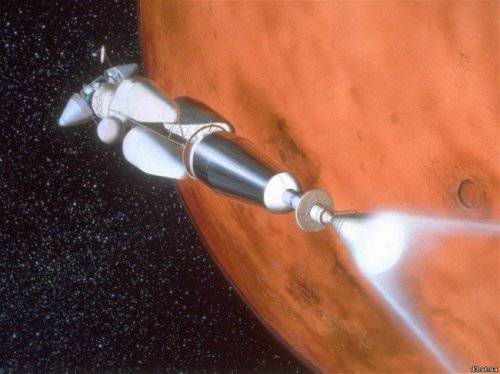Laser propulsion: the “wild” idea can finally shine
New experiments on the laser show that you can build a hypersonic aircraft and raise the spacecraft beam to Earth orbit.
In fact, revolutionary laser-powered ships can replace jet planes on modern commercial journeys. Passengers could be transferred from one side of the planet to the other in less than an hour - just enough time to open these impenetrable sachets of peanuts. Moreover, the thrust on the radiated energy can make the flight into orbit easy, and not difficult and dangerous.
Lick Mairabo, a professor of applied mechanics at the Rensselier Polytechnic Institute in Troy, New York, believes this. He is an expert in controlled energy devices, aerospace systems, space power installations and advanced types of traction.
For the past three decades, Mairabo’s burning desire was to create and demonstrate a viable concept of non-chemical traction for future flight crews in his research with Lightcraft Technologies, Inc. of Bennington, Vermont.
“Usually, for a new technology, you need 25 for years to mature ... until you can apply it. Yes, now is the time, ”Mayrabo told SPACE.com
Real iron ... real physics
Most significant news in the field of radiated energy, this is what the experiment is currently underway at the Henry T. Nagamatsu Hypersound and Aeronautics Laboratory in San José dos Campos, Brazil.
The work is funded under an international cooperation agreement by the United States Air Force and Brazilian Air Forces Research.
Basic research experiments use high-power lasers in Brazil, where experts explore the fundamentals of the physics of laser-heated air jets and laser pulsating engines for future high-energy ships.
In the Brazilian laboratory, a hypersonic shock tunnel is connected to two pulsed infrared lasers that at peak power reach an order of gigawatts — today it is the highest power achieved in experiments on laser pulses, Mayrabo explains.
“In the laboratory, we are testing full-size engines that should revolutionize space travel,” emphasizes Mayrabo. “These are real products. This is real physics. We get real data ... and this is not paper research. "
“Right now we are receiving data,” Mairabo explains. “When you start the engine, it’s a real crash. The sound, as if fired from a gun inside the lab. It's really loud. ”
Experiments on a laser, adds Mirabo, also have to do with launching nanosatellites (weighing from 1 to 10 a kilogram) and microsatellites (from 10 to 100 a kilogram) into low-Earth orbit.
Highways of light
Creation and flights of “highways of light” for Mayrabo were methodical, step by step, work.
From 1996 to 1999, he launched prototypes of his devices with a ten-kilowatt infrared laser at a missile range in White Sands, New Mexico. In 2000, sponsored by a grant from his company, he set a world altitude record: over 230 feet (71 meter) for laser-lifted models in free flight.
Mairabo co-authored with John Lewis, in his new book, The LI-20 Laser Build Handbook, recently published by Apogee, explains his desire for affordable, safe access to space using a laser-driven ship.
“Concerning high energy physics ... movement through the atmosphere with the help of radiated energy ... there is not enough experience in the world to make such things real. This is completely beyond the ordinary, ”Mairabo explains. - “I've been working on this for 30 years. I know how to do it. ”
As Mairabo explains, for decades laser physicists have been dreaming of attaining a cost of laser energy of two dollars per watt. “We have achieved this. Now it is a question of the will and whether we want to do this. This technology is now within commercial reach. ”

Information